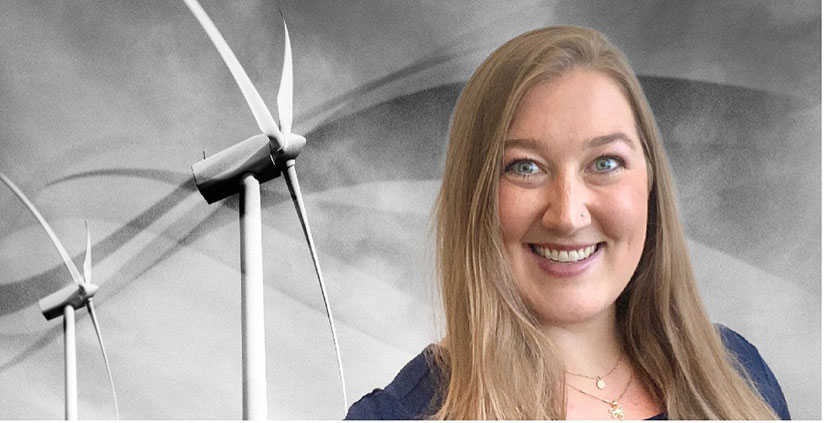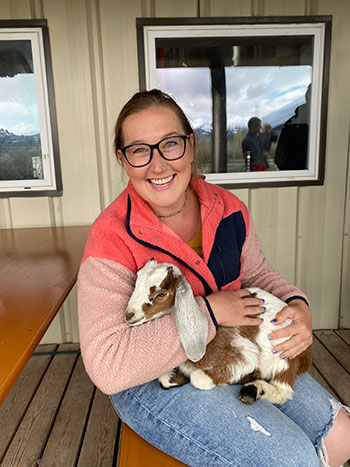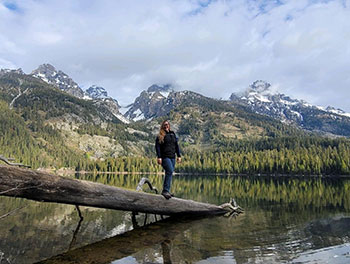Behind the Blades: How Lanaia Carveth Keeps the Gears Turning
A Wind Energy Project Manager Reflects on Her Transition From Construction to Wind Energy

The National Renewable Energy Laboratory’s (NREL’s) wind energy program is known for pioneering components and systems that have helped take wind energy technologies to new heights. NREL’s world-class researchers achieve these innovations thanks, in part, to support from project managers who keep projects on schedule and on budget.
Take Lanaia Carveth, who transitioned from a career as a consultant in the construction industry doing environmental planning, permitting, regulatory compliance, and project management to her current role as a project manager at NREL’s National Wind Technology Center (NWTC).
“I’m the one who makes sure our researchers fill out the forms they’re supposed to when they’re supposed to,” Carveth said. “Essentially, I am the organizer—which is hilarious if you see my desk. I handle things like budgets, schedules, meetings, subcontracting, and reporting so that our researchers can do what they do best: focus on their research.”
Carveth took a break from building a schedule for a new project on transmission planning in the Gulf of Mexico to explain her work, her inspiration for pursuing a job at NREL, and the importance of getting one’s hands dirty.
To start, what do you do at NREL in layperson’s terms?

“I find ways to meet changing conditions with alternative plans so that we deliver what we say we will—and [so] we take care of each other at the same time,” explained Carveth, shown here holding a baby goat at the Winter Winds Goat Farm in Jackson Hole, Wyoming. Photo from Lanaia Carveth, NREL
I help manage projects primarily in NREL’s wind systems integration portfolio, which usually includes people in our Power Systems Engineering Center, Grid Planning and Analysis Center, and Cybersecurity Center.
Taking a more zoomed-out view, I work with researchers on team cohesion, both within NREL, where we have so many employees in different roles and across different areas of research, and with the Department of Energy (DOE) and non-DOE partners. I find ways to meet changing conditions with alternative plans so that we deliver what we say we will—and [so] we take care of each other at the same time.
Those certainly are important duties. What led you to your job at NREL?
I grew up in Arvada, Colorado, which is close to both NREL’s South Table Mountain Campus and Flatirons Campus, so I’ve been aware of the lab for a long time. I also love being in nature, and I know we need to make some major shifts to preserve nature’s beauty and our planet’s health. That made me want to work in renewable energy, which led me to look for jobs at NREL, but renewable energy wasn’t exactly my background. I have an environmental science degree, and I worked in construction as an environmental and planning consultant for several years.
But I wanted to work someplace where I could help make the world a better place. Even though I have a background in science, I’m not as likely to dive deep into one area of research—I’m more of a generalist, big-picture thinker. I wanted to find an organization where I could use that strength to support the people doing the specialized technical work. I also have a few friends from high school who went on to work at NREL. When I saw NREL was looking for a project manager at the NWTC, I asked my old friends if they’d recommend NREL as a place to work and their response was wonderfully positive, so I applied and got the job!

Carveth, shown here hiking in Grand Teton National Park, applied for a job at NREL in part because of her love of nature and her desire to preserve our planet’s health. Photo from Lanaia Carveth, NREL
That’s great to hear! Has NREL lived up to those glowing reviews?
I’ve been able to apply the strengths I developed earlier in my career, and I’ve also learned and grown in some very positive ways. I love working with so many people from various centers around the lab every day, learning about new areas of research, and knowing that our work has benefits that reach far beyond the lab. Now that I’ve been here a few years, I’ve realized another thing that led me to NREL was that I wanted to be part of a community of people with curious minds and a desire to do good. And I’ve found that here. NREL’s mission—to lead research, innovation, and strategic partnerships and deliver solutions for a clean energy economy—is a huge motivator.
Knowing the far-reaching, positive impact of your work, what projects or milestones are you especially excited about right now?
In terms of public-facing projects, the completion of the Atlantic Offshore Wind Transmission Study was a major accomplishment for NREL wind energy research. Currently, I’m working on the West Coast Offshore Wind Transmission Study and a precursor study for the Gulf of Mexico. These studies will generate critical information for planning how the electricity generated by offshore wind turbines and wind plants gets to shore and connected to the grid.
In terms of accomplishments that are more internal to the world of NREL, I am so proud of my team of project managers at the NWTC. When I started, the team was about six people, and we were really working to define our roles at the center. We now have nine dedicated project managers plus three more “adopted” project managers who work in areas other than wind energy but join our meetings and group chats to collaborate and support each other. My team created a manual that outlines and defines our processes and procedures, which allows us to operate more efficiently and provide more standardized support. Thanks to that resource, as well as our growth and our collaborative community, we provide high-quality, reliable project management that is well recognized at the NWTC.
Sounds like you have a lot to be proud of. Any advice for readers who want to do what you do?
First, be a team player at all levels. When I worked in the construction industry, I advocated for anyone pursuing a management track to do the “field work” first. This provides the base experience and awareness needed to plan and execute the work, as well as an awareness of people’s experiences at every level. I think a similar principle carries over to NREL. Any project manager needs to have some in-depth training on scope, schedule, budget, and people management, but I think people also need to spend some time in the trenches and get their hands dirty. At NREL, that looks a little different than it did in construction, but ultimately, it means you get exposure to all aspects of the projects, you make mistakes in a safe setting, and then you take on more responsibility as it presents itself—because it inevitably will.
Second, take every opportunity that comes your way and treat it like a learning experience. Don’t be afraid to take lateral moves or just explore new paths. Get experience in different fields, even if you never considered that your direct path. My best growth experiences have come from saying “yes” to opportunities as they come, even if I don’t know exactly what I’m getting myself into, and remaining confident in my ability to learn, deliver, and ask for help when needed. Get curious and put yourself in situations where you can refine your strengths, develop new ones, and then share them with others.
Finally, what are your hopes for the future of wind energy?
I hope to see responsible wind energy development that is built on the great information—especially on wind energy’s environmental and social impacts—coming from our national labs, academia, and industry. Using that knowledge base, I hope to see wind energy continue to grow and be an integral part of the renewable energy mix so that we can reduce our dependence on fossil fuels and our impact on the planet.
Learn more about NREL’s wind energy research, offshore wind energy in particular, and the amazing people behind the blades by subscribing to the Leading Edge newsletter.
Last Updated May 28, 2025
